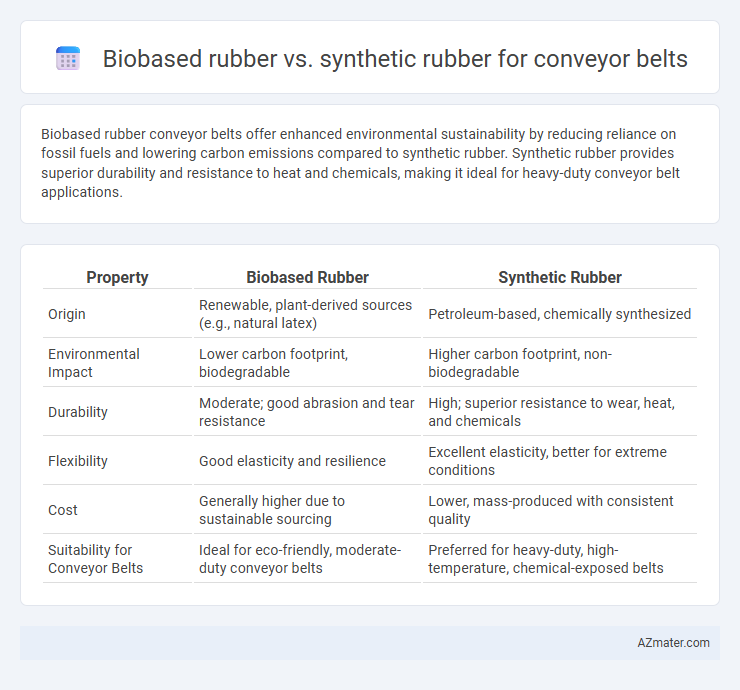Biobased rubber conveyor belts offer enhanced environmental sustainability by reducing reliance on fossil fuels and lowering carbon emissions compared to synthetic rubber. Synthetic rubber provides superior durability and resistance to heat and chemicals, making it ideal for heavy-duty conveyor belt applications.
Table of Comparison
| Property | Biobased Rubber | Synthetic Rubber |
|---|---|---|
| Origin | Renewable, plant-derived sources (e.g., natural latex) | Petroleum-based, chemically synthesized |
| Environmental Impact | Lower carbon footprint, biodegradable | Higher carbon footprint, non-biodegradable |
| Durability | Moderate; good abrasion and tear resistance | High; superior resistance to wear, heat, and chemicals |
| Flexibility | Good elasticity and resilience | Excellent elasticity, better for extreme conditions |
| Cost | Generally higher due to sustainable sourcing | Lower, mass-produced with consistent quality |
| Suitability for Conveyor Belts | Ideal for eco-friendly, moderate-duty conveyor belts | Preferred for heavy-duty, high-temperature, chemical-exposed belts |
Introduction to Conveyor Belt Materials
Conveyor belts commonly use rubber materials for durability, flexibility, and resistance to wear and chemicals. Biobased rubber, derived from renewable natural sources like latex or natural rubber, offers eco-friendly advantages such as biodegradability and lower carbon footprint. Synthetic rubber, produced from petroleum-based polymers such as styrene-butadiene or neoprene, provides enhanced resistance to heat, oils, and abrasion, making it suitable for heavy-duty conveyor belt applications.
What is Biobased Rubber?
Biobased rubber is derived from renewable natural resources such as plants and latex, offering an eco-friendly alternative to traditional synthetic rubber used in conveyor belts. It provides comparable durability and flexibility while reducing reliance on petroleum-based materials, contributing to lower carbon footprints in industrial applications. Innovations in biobased rubber formulations enhance its resistance to wear, heat, and chemicals, making it increasingly viable for conveyor belt manufacturing.
Defining Synthetic Rubber
Synthetic rubber, a man-made elastomer composed primarily of polymers derived from petroleum byproducts such as styrene and butadiene, offers superior resistance to abrasion, heat, and chemicals compared to natural or biobased rubbers. In conveyor belt applications, synthetic rubber enhances durability and performance under harsh industrial conditions, including exposure to oils, solvents, and extreme temperatures. This engineered material ensures consistent mechanical strength and flexibility, making it a preferred choice for heavy-duty conveyor systems requiring long service life and minimal maintenance.
Environmental Impact Comparison
Biobased rubber for conveyor belts significantly reduces carbon emissions due to its renewable plant-based sources, unlike synthetic rubber derived from petroleum, which involves energy-intensive extraction and refining processes. Biobased rubber also offers improved biodegradability, minimizing long-term environmental pollution and landfill accumulation common with synthetic alternatives. The lower reliance on fossil fuels and decreased toxic byproducts position biobased rubber as a more sustainable choice for conveyor belt applications.
Performance and Durability Analysis
Biobased rubber conveyor belts exhibit enhanced environmental sustainability by incorporating renewable materials while maintaining competitive tensile strength and abrasion resistance compared to synthetic rubber. Synthetic rubber belts, typically made from styrene-butadiene (SBR) or nitrile butadiene rubber (NBR), offer superior resistance to oil, heat, and aging, resulting in longer service life under harsh industrial conditions. Performance analysis reveals that while biobased options reduce carbon footprint, synthetic rubber remains the preferred choice for heavy-duty applications due to its proven durability and consistent mechanical properties.
Cost Efficiency and Economic Considerations
Biobased rubber for conveyor belts offers a cost-efficient alternative by reducing reliance on petroleum-based raw materials, leading to price stability amid fluctuating oil markets. Synthetic rubber, while generally cheaper upfront due to mass production and established supply chains, may incur higher long-term costs related to environmental compliance and disposal. Economic considerations favor biobased rubber when accounting for lifecycle savings, sustainability incentives, and potential regulatory benefits that enhance overall return on investment.
Sustainability and Circular Economy
Biobased rubber used in conveyor belts significantly reduces reliance on fossil fuels by deriving materials from renewable resources like natural latex and plant oils, promoting sustainability. Unlike synthetic rubber, which is petroleum-based and contributes to carbon emissions, biobased alternatives offer improved biodegradability and facilitate recycling processes that align with circular economy principles. Implementing biobased rubber enhances eco-friendly production cycles and supports resource regeneration, crucial for reducing environmental impact in industrial applications.
Applications and Industry Adoption
Biobased rubber for conveyor belts is gaining traction in industries such as food processing, agriculture, and mining due to its sustainability and biodegradability, reducing environmental impact during disposal. Synthetic rubber remains dominant in heavy-duty applications, including steel, cement, and automotive sectors, because of its superior abrasion resistance, heat tolerance, and chemical stability. Manufacturing companies increasingly adopt biobased rubber composites to meet eco-friendly regulations while maintaining performance standards required in diverse industrial conveyor belt systems.
Future Trends in Conveyor Belt Manufacturing
Biobased rubber for conveyor belts is increasingly favored due to its sustainability, reduced environmental impact, and renewable raw material sources, aligning with global demand for greener industrial solutions. Synthetic rubber remains dominant because of its superior durability, resistance to abrasion, and cost-effectiveness, yet innovations aim to blend biobased polymers with synthetic compounds to enhance performance and eco-friendliness. Future trends in conveyor belt manufacturing highlight a shift towards hybrid materials and advanced bio-composites, driven by regulatory pressures and the circular economy's emphasis on recyclability and reduced carbon footprint.
Conclusion: Choosing the Right Rubber for Conveyor Belts
Biobased rubber offers enhanced environmental sustainability and reduced carbon footprint compared to synthetic rubber, making it ideal for eco-conscious conveyor belt applications. Synthetic rubber delivers superior wear resistance, chemical stability, and consistent performance under extreme conditions, preferred in heavy-duty industrial settings. Selecting the appropriate rubber depends on balancing environmental impact, durability requirements, and operational conditions specific to the conveyor belt application.

Infographic: Biobased rubber vs Synthetic rubber for Conveyor belt
 azmater.com
azmater.com